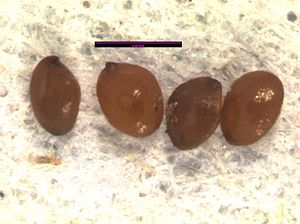Difference between revisions of "Triodanis perfoliata"
(→Photo Gallery) |
(→Photo Gallery) |
||
| Line 57: | Line 57: | ||
<gallery> | <gallery> | ||
Image:329 2011615214815.jpg | Image:329 2011615214815.jpg | ||
| + | Image:4825927636 e7de0e13b4.jpg | ||
</gallery> | </gallery> | ||
Revision as of 12:09, 7 May 2012
- Scientific Name: Triodanis perfoliata
- Family: Campanulaceae
- English Names: Venus's looking glass, clasping bellwort
- Other Names: Specularia perfoliata
Contents
Taxonomy
- Kingdom: Plantae
- (unranked): Angiosperms
- (unranked): Eudicots
- (unranked): Asterids
- Order: Asterales
- Family: Campanulaceae
- Genus: Triodanis
- Species: T. perfoliata
Description
General: Erect annual herbs, the stems erect, usually simple, 1-6 dm. tall, the surface rough.
Leaves: Leaves alternate, sessile, cordate-clasping, rotund-ovate, palmately veined, the leaves 0.5-3 cm. long and wide, or the lowermost ones narrower, more obovate, and short-petiolate.
Flowers: Flowers sessile in the axils of the middle and upper leaves, 1-several in each axil, in a leafy, spike-like arrangement; calyx lobes 5, divided to the base, narrowly triangular and pointed, 5-8 mm. long; corolla united, regular, the 5 lobes longer than the tube, 8-13 mm, long, deep purple to pale lavender; stamens 5, free from the corolla and from each other; the lower flowers do not open and the calyx of these is smaller and 3- or 4-lobed; ovary inferior.
Fruit: Capsules oblong, 2- or 3-celled, about 1 cm. long in the open flowers, half that size in the others.
Bloom Period
- Flowering time: May to June
- Fruit ripening time: June to July
Distribution
Habitat
Common weed species growing in waste places, disturbed sites, pastures, prairies, and roadsides [1]. Dry woods and open sites (Justice and Bell, 1968). Dry to moderately dry soils [2].
Uses
Site Rehabilitation
Useful for attracting pollinating insects. Fibrous roots have the capacity to stabilize disturbed soils [3] [4]
Wildlife
Attracts mega-chilid bee, sphecid wasps, leatherwing beetles [5]
Landscpaing
Annual species but possible to mass in beds for pleasing purple colour.
First Nations
Liquid compound of root taken for dyspepsia from overeating; Infusion of roots taken and used as a bath for dyspepsia; Used as an emetic; Smoked at ceremonies.
Propagation
Seed Propagation
- Seed collection time: June-August
- Crop intervals: Annual
Fruit and Seed Collection and Extraction
Collect capsules by hand into collection bags. Allow to dry, and then shake collection bags to release seeds.
Fruit/Seed Dormancy and Treatment
Sow seeds outdoors in flats or containers in late summer or early fall and allow dormancy to be broken naturally.
Outplanting Characteristics and Requirements
Plant in full sun to partial shade in coarse-textured, free-draining soils.
Photo Gallery
References
Garry Oak Ecosystems Recovery Team Propagation Guidelines
Burke Museum, Univeristy of Washington
University of Michigan Dearborn Native American Ethnobotany Database



